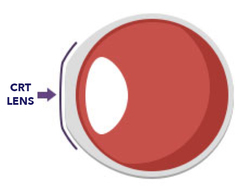
Myopia control treatments
The most promising results to-date have come from pharmacological treatments. Atropine is one of two drugs that appear to slow myopia progression. Atropine is better known as one of the drug used to dilate the pupil of the eye and/or prevent accommodation in the diagnostic and treatment of ocular diseases. It is a very potent drug and is not without side-effects as a myopia treatment; bifocal corrections and sun glasses are also generally necessary adjuncts to this therapy. A related, more selective drug, pirenzepine, is currently in clinical trial. As alluded to already above, bifocal corrections have also been trialed as myopia treatments, with “esophoric myopes” being the most likely to benefit. Finally, the possibility that rigid contact lenses may slow the progression of myopia is attracting renewed interest; existing evidence in support of their use is mostly anecdotal. Note that rigid contact lenses may also be used to mold the front corneal surface of the eye and so reduce its refracting (focusing) power. In some patients the reduction in myopia achieved by sleeping in such lenses is sufficient to allow them to go without optical correction during the day. The modern version of this technique is known as corneal refractive therapy (CRT). This technique is more closely related to the refractive surgeryprocedures (PRK, Lasik), that also modify the optical power of the cornea. Neither qualify as treatments as neither are known to slow ocular growth.
The most promising results to-date have come from pharmacological treatments. Atropine is one of two drugs that appear to slow myopia progression. Atropine is better known as one of the drug used to dilate the pupil of the eye and/or prevent accommodation in the diagnostic and treatment of ocular diseases. It is a very potent drug and is not without side-effects as a myopia treatment; bifocal corrections and sun glasses are also generally necessary adjuncts to this therapy. A related, more selective drug, pirenzepine, is currently in clinical trial. As alluded to already above, bifocal corrections have also been trialed as myopia treatments, with “esophoric myopes” being the most likely to benefit. Finally, the possibility that rigid contact lenses may slow the progression of myopia is attracting renewed interest; existing evidence in support of their use is mostly anecdotal. Note that rigid contact lenses may also be used to mold the front corneal surface of the eye and so reduce its refracting (focusing) power. In some patients the reduction in myopia achieved by sleeping in such lenses is sufficient to allow them to go without optical correction during the day. The modern version of this technique is known as corneal refractive therapy (CRT). This technique is more closely related to the refractive surgeryprocedures (PRK, Lasik), that also modify the optical power of the cornea. Neither qualify as treatments as neither are known to slow ocular growth.
